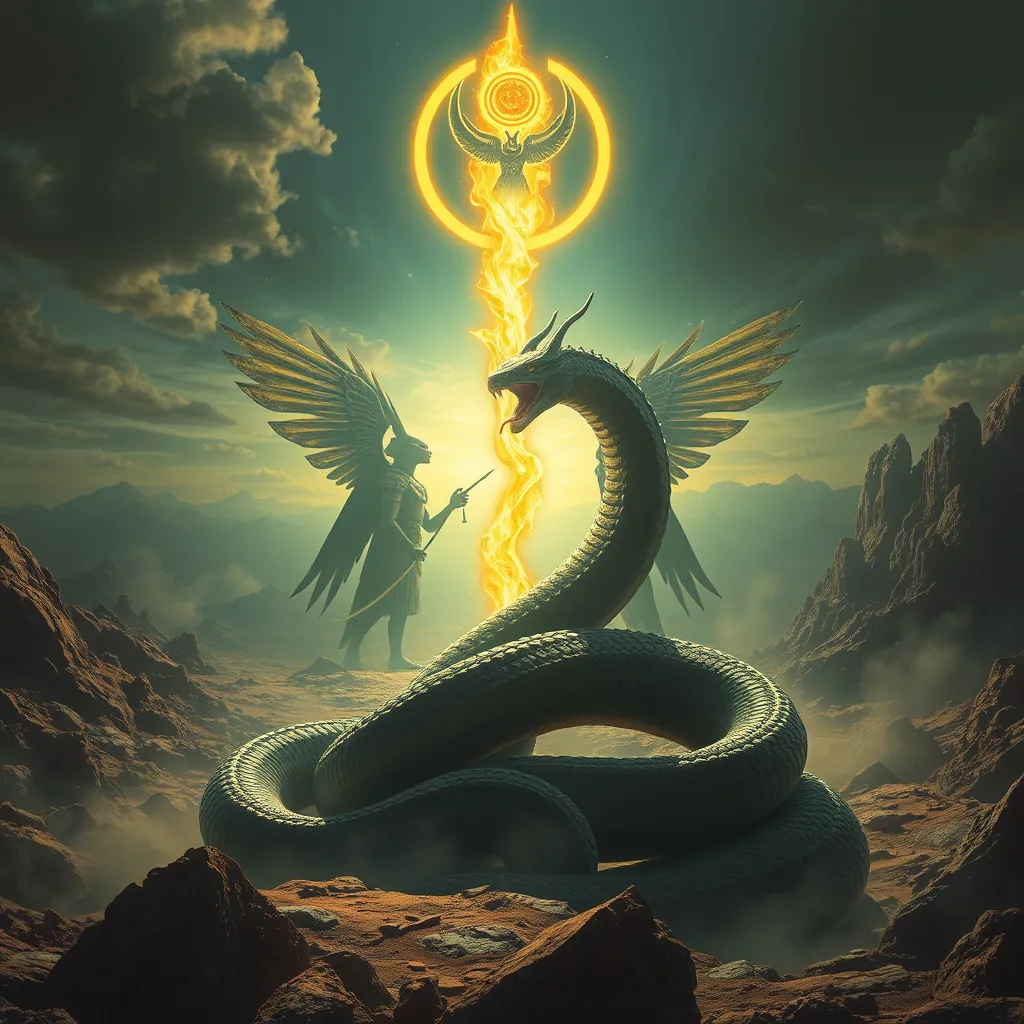Apep: The Serpent of Chaos and His Eternal Battle Against the Sun God Ra
I. Introduction
Apep, also known as Apophis, is a significant figure in Egyptian mythology, embodying chaos and destruction. His existence is intertwined with the daily struggle against the sun god Ra, representing the eternal conflict between order and chaos. As the sun traverses the sky, Apep lies in wait, seeking to devour Ra and plunge the world into darkness. This article delves into the origins, characteristics, and cultural significance of Apep, as well as his ongoing battle with Ra.
II. The Origins of Apep
Apep’s origins are rooted in ancient Egyptian creation myths, where he is often depicted as a primordial being formed from the chaos that existed before creation. According to some stories, Apep emerged from the waters of Nun, the chaotic abyss, representing the unformed state of the universe.
He is primarily represented as a massive serpent, symbolizing chaos and disorder. The snake has long been a powerful symbol across various cultures, often embodying duality—representing both creation and destruction. In ancient Egypt, Apep’s serpent form emphasizes his role as the embodiment of chaos.
III. Apep’s Characteristics and Attributes
Apep is often depicted as a colossal serpent, with a long, sinuous body that can coil and constrict. His skin is frequently described as dark, symbolizing the void and chaos that he embodies. In Egyptian art, he is portrayed with glowing eyes, representing the malevolence and danger he poses.
- Associations with Darkness: Apep is strongly linked to the night and its associated fears, representing the unknown that lurks in darkness.
- Storms and Chaos: He is often associated with storms, lightning, and tumultuous weather, embodying the chaotic forces of nature.
- Duality: While Apep is primarily seen as a destructive force, he also represents the necessary chaos that allows for renewal and transformation.
IV. The Role of Ra in Egyptian Mythology
Ra, the sun god, holds a central position in Egyptian mythology. He is often depicted with a falcon head and a sun disk above it, symbolizing light, order, and creation. Ra’s journey across the sky is a daily battle against Apep, signifying the struggle between light and darkness.
Ra’s journey is crucial for maintaining cosmic order. Each day, as he rises in the east and sets in the west, he symbolizes rebirth and the cyclical nature of life. His role as a protector against chaos is paramount, continually fighting to keep Apep at bay.
V. The Eternal Conflict: Apep vs. Ra
The conflict between Apep and Ra is a central theme in Egyptian cosmology. Every night, as Ra travels through the underworld, Apep attempts to ambush him. This daily battle is not just a physical struggle but a symbolic representation of the ongoing fight between chaos and order.
The significance of this struggle is profound, influencing various aspects of Egyptian life and spirituality. Egyptians believed that by defeating Apep, Ra ensured the stability of the cosmos and the continuation of life.
- Rituals: Egyptians performed numerous rituals and prayers to protect Ra and ward off Apep’s influence. These included reciting spells from the “Book of the Dead” and offerings to the gods.
- Protective Amulets: Amulets featuring depictions of Ra or symbols of protection were common, believed to provide safety against Apep’s chaos.
VI. Apep’s Influence on Ancient Egyptian Culture
Apep’s presence permeated ancient Egyptian art and literature. He was often depicted in tomb paintings, emphasizing the importance of his defeat in the afterlife journey. Apep’s imagery served as a reminder of the ever-present dangers of chaos that must be combated.
The cultural impact of Apep’s mythology is evident in various festivals and practices aimed at celebrating Ra’s victory over Apep. One notable event was the “Feast of the Valley,” which included rituals to honor the gods and reinforce the triumph of order over chaos.
VII. Legacy of Apep in Modern Context
In contemporary interpretations of mythology, Apep has taken on new meanings. He is often seen as a symbol of the chaos inherent in human existence, representing the struggles individuals face in their lives. His character serves as a reminder of the challenges posed by disorder and the importance of resilience.
Modern literature and media have drawn inspiration from Apep’s narrative, portraying him as a metaphor for chaos in various forms. The themes of chaos versus order resonate in popular culture, appearing in movies, books, and art.
- Comparative Mythology: Apep can be compared to other mythological figures representing chaos, such as Typhon from Greek mythology or the serpent in Norse mythology.
- Symbol of Resistance: In modern contexts, Apep symbolizes the resistance against oppressive forces, reflecting societal struggles against chaos and disorder.
VIII. Conclusion
Apep’s significance in mythology and culture cannot be overstated. As the embodiment of chaos, he represents the challenges that must be faced in the quest for order and stability. The ongoing battle between Apep and Ra serves as a powerful metaphor for the struggles inherent in life, illustrating the constant interplay between light and darkness.
As we reflect on the legacy of Apep and Ra, we recognize the enduring relevance of their conflict. This ancient narrative continues to inspire and inform our understanding of chaos and order in the modern world, reminding us of the perpetual balance we must maintain.




